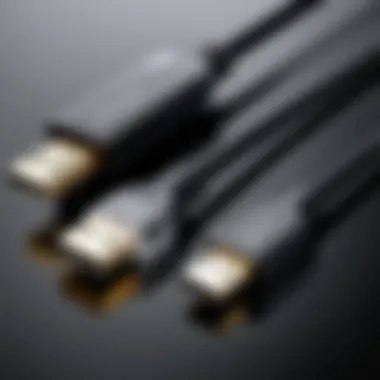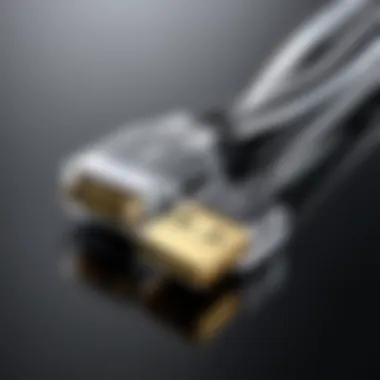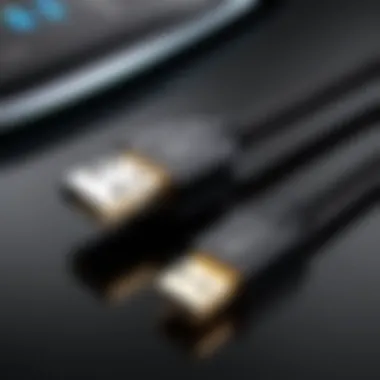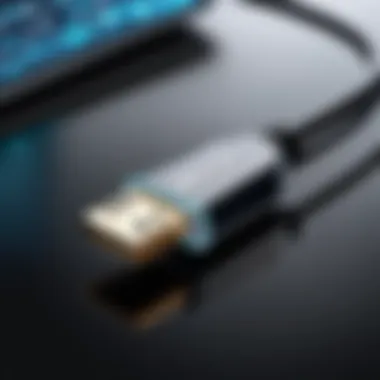Exploring the 3 ft Micro USB Cable: Specs and Benefits


Intro
The 3 ft micro USB cable has become a significant component in today’s technology ecosystem. Its compact length allows for easy connectivity without the clutter of excess wire. This article aims to dissect this essential accessory, examining its specifications, various applications, and the distinct benefits it offers over other cable types. As more devices adopt USB standards, understanding these cables becomes crucial for both tech enthusiasts and casual users alike.
Product Overview
Brief Description
The micro USB cable is a smaller version of the standard USB cable. Usually measuring 3 feet in length, it is designed for connecting various devices, such as smartphones, tablets, and more, to power sources or data ports. This size is ideal for scenarios where space is at a premium, allowing for efficient charging or data transfer.
Key Features
- Compact Design: The 3 ft length enables easy handling and storage.
- Versatile Compatibility: Works with multiple devices, enhancing its usability.
- Durable Construction: Often built with robust materials to withstand daily wear.
- Fast Data Transfer Speed: Facilitates speedy synchronization and charging.
Available Variants
While the basic micro USB cable remains the same, there are several variants available:
- Standard Micro USB: Ideal for most devices.
- High-Speed Micro USB: Offers enhanced transfer capabilities.
- Right Angle Micro USB: Provides improved ergonomics in tight spaces.
Specifications Breakdown
Technical Specifications
Typical specifications for a 3 ft micro USB cable include:
- Connector Type: Micro USB Type-B
- Length: 3 feet (0.9 meters)
- Data Transfer Speed: Up to 480 Mbps
- Charging Current: Up to 2.4 A
Performance Metrics
The performance of a micro USB cable often hinges on its construction. A well-made cable can facilitate faster charging and maintain a steady data transfer rate. Key metrics to consider include:
- Charging Time: Time taken to fully charge devices.
- Data Transfer Rate: Speed at which files move between devices.
Compatibility Information
In terms of compatibility, most modern devices will work seamlessly with a micro USB cable. It's essential to check device specifications to confirm if a micro USB connection is supported.
Comparative Analysis
Competing Products
The market also offers alternatives to the micro USB cable, such as:
- USB-C cables, which are becoming increasingly common due to their reversible design and higher power delivery capabilities.
- Lightning cables are specific to Apple devices, limiting versatility.
Strengths and Weaknesses
- Strengths:
- Weaknesses:
- Good compatibility with many devices.
- Low cost.
- Slower charging compared to newer standards like USB-C.
- Limited lifespan if not taken care of.
Price Comparison
Prices for 3 ft micro USB cables can vary based on manufacturer and quality. Generally, range from $5 to $20, depending on features like fast charging capacity and durability.
Buying Guide
Target User Profiles
- Tech Enthusiasts: Likely to appreciate superior data transfer speeds.
- Casual Users: May prioritize affordability without much concern for specifications.
Important Considerations
When selecting a 3 ft micro USB cable, consider:
- Purpose: What will it be used for? Charging vs data transfer.
- Device Compatibility: Ensure it works with your specific devices.
- Quality: Look for cables with reinforced connectors.
Insider Tips for Buyers


- Check for user reviews to gauge performance.
- Be aware of return policies in case of defects.
Maintenance and Upgrade Insights
Regular Maintenance Practices
To prolong the lifespan of a micro USB cable, one should:
- Avoid excessive bending or pulling of the cable.
- Store it properly—rolling is preferable over folding.
Upgrade Paths and Options
Considering future-proofing?
- USB-C may become necessary as devices evolve.
- Look for dual-purpose cables that cater to multiple types.
Troubleshooting Common Issues
Common problems with micro USB cables may include:
- Insufficient Charging: Check for debris in the connector.
- Slow Data Transfer: Ensure cables are of high quality and suitable for your device's specs.
The micro USB cable remains a reliable standard in the face of evolving technology, providing essential connectivity for a wide range of devices. Understanding its functionality and applications ensures users make the most of this compact and versatile tool.
Intro to Micro USB Cables
Micro USB cables have become an essential part of the modern electronic ecosystem. They facilitate the connection and charging of various devices, ranging from smartphones to gaming consoles. Understanding these cables is vital as they serve practical purposes in our daily lives. This section introduces the concept of Micro USB cables, discusses their importance, and highlights key considerations for their use.
Definition and Purpose
A Micro USB cable is a compact version of the Universal Serial Bus (USB) standard. This cable allows for both data transfer and power supply between devices. Its small connector is particularly beneficial for portable devices, making it easier to connect without taking up too much space. Essentially, these cables power devices and enable communication between them, ensuring productivity and convenience.
In today's world, where connectivity is paramount, Micro USB cables play a crucial role. They are typically used to charge smartphones, tablets, and various electronic gadgets. The versatility of this cable type is essential; it bridges the gap between different devices and chargers. Moreover, they allow users to transfer data between devices like computers and smartphones efficiently.
The Evolution of USB Technology
The history of USB technology dates back to the mid-1990s. Initially, USB was developed to simplify the process of connecting devices and replace a multitude of connectors. Over the years, USB has evolved significantly, impacting how we perceive device connectivity.
Micro USB was introduced as a successor to the Mini USB standard. This transition marked a shift toward smaller connectors that could support thinner devices. By the late 2000s, Micro USB became the go-to standard for mobile devices. This culmination of advancements in USB technology reflects the demand for multi-functional, compact, and user-friendly connectors.
As technology progressed, newer standards like USB-C emerged, offering advanced features such as faster data transfer rates and reversible connectors. However, Micro USB cables remain relevant due to their widespread adoption. Many devices still rely on this connector, making it important for users to understand its specifications and functionalities. Thus, Micro USB continues to hold a significant place in the electronics landscape, merging the legacy of older technology with the needs of current devices.
Understanding the ft Micro USB Cable
The 3 ft Micro USB cable stands as a crucial component in the digital connectivity landscape. Its design, functionality, and versatility make it not just a simple accessory but an essential tool for many electronic devices. This section explores the technical specifications, design aspects, and unique attributes that contribute to its popularity.
Technical Specifications
Data Transfer Rates
Data transfer rates define how quickly data moves from one device to another. In the case of the 3 ft Micro USB cable, standard rates can range up to 480 Mbps, which is considered sufficient for most applications. This characteristic makes the cable a beneficial choice for users who need efficient and reliable data transfer. The capability to handle various tasks, from syncing files to updating device firmware, showcases its utility. However, considering newer USB standards, users should assess their needs, especially if large data transfers are frequent.
Voltage and Current Ratings
Voltage and current ratings are fundamental for ensuring that devices receive the appropriate power. For a 3 ft Micro USB cable, the voltage rating is usually 5V, which aligns with the power needs of most small electronics. Current ratings can vary, with values often around 2A, enough for smartphones and tablets. This rating provides a balance between quick charging and device safety. Despite its efficiency, users must ensure that their devices support these ratings to prevent any power-related issues.
Material Quality
Material quality directly impacts both durability and performance of the 3 ft Micro USB cable. High-quality cables often use a combination of copper and insulation materials that increase longevity and reduce signal degradation over time. The design may include shielding that protects against interference. This characteristic makes it a popular choice among consumers looking for a reliable product. However, low-quality cables may offer cheaper alternatives, they often result in a subpar experience.
Design and Build Quality
Cable Construction
The construction of the 3 ft Micro USB cable involves several factors including gauge size, length, and flexibility. A well-constructed cable generally features a finer gauge for improved flexibility and ease of use. This is especially crucial for portable setup. The choice of materials in the build also impacts its overall functionality and adaptability. A robust construction enhances the cable's use in varied environments, making it standby for regular use.
Durability Features
Durability is among the top considerations when selecting a Micro USB cable. Features like reinforced connectors and strain relief can significantly affect how well a cable holds up over time. Many models are designed to withstand repeated bending and pulling, which ultimately extends their lifespan. While durability can lead to a higher price point, the increased longevity often justifies the investment in many cases.
Common Uses of ft Micro USB Cables


Understanding the common uses of the 3 ft Micro USB cable is essential. This cable has proven its versatility in various contexts. It is not only popular for charging devices but also serves crucial data transfer functions and peripheral connections. Such functionalities make it a vital component in daily tech interactions.
Charging Electronic Devices
Charging is the primary role of the 3 ft Micro USB cable. It supports rapid charging for many devices. Smartphones and tablets commonly use this cable for power supply. With proper adapters, it can connect to wall chargers, power banks, or computer USB ports. This flexibility allows users to charge in various settings, whether at home or on the go.
Moreover, the compact design of the 3 ft length strikes a balance. It isn't too long, which can create clutter, but it offers enough reach for convenient use. Users appreciate the ability to keep connected without being limited by a short cable. This aids in maintaining comfort while actively using the device during charging.
Data Transfer Applications
In addition to charging, data transfer stands as a significant use case for the 3 ft Micro USB cable. Many electronic devices facilitate file sharing and synchronization. This includes transferring photos, music, and documents from cameras and smartphones to computers. With USB 2.0 technology, these cables often allow transfer rates up to 480 Mbps, making them efficient for users who deal with large files.
Micro USB cables are also essential for connecting devices for updates. For example, software updates can be downloaded directly to devices using the cable connection. This ensures devices operate on the latest software, thus enhancing performance and security.
Connecting Peripherals
The 3 ft Micro USB cable also serves as a conduit for connecting various peripherals. Many gadgets, such as external hard drives, game controllers, and printers, utilize this cable type. Its compatibility with diverse devices adds to its functionality and makes it a staple accessory for tech users.
For gamers, connecting controllers through Micro USB enables seamless gameplay. This eliminates the need for additional wireless setups or batteries. Many gaming setups benefit from having a reliable, wired connection that reduces latency, improving user experience.
The 3 ft Micro USB cable remains relevant in an evolving tech landscape. Users should recognize its value across multiple functions. With increasing reliance on various devices, understanding these common uses helps in optimizing day-to-day tech activities.
Benefits of Using a ft Micro USB Cable
The 3 ft Micro USB cable offers numerous advantages that cater to both casual users and tech enthusiasts. It is significant to understand these benefits to make informed decisions about your connectivity solutions. This section delves into the strengths of the 3 ft Micro USB cable, focusing on portability, user-friendliness, and cost-effectiveness. These elements contribute to its status as a go-to option for many.
Compact and Portable Design
One of the most notable benefits of the 3 ft Micro USB cable is its compact and portable design. The length is particularly suited for a variety of situations, whether you are at home, in a workplace, or on the go. It fits easily into bags, pockets, or even in a drawer without taking up much space. This convenience makes it an ideal choice for travel.
Moreover, the shorter length minimizes clutter, reducing the chances of tangling which can often occur with longer cables. It allows for organized connectivity without excess wire. Many users appreciate that they can maintain a cleaner, more streamlined look on their desks or charging stations.
Ease of Use
Using a 3 ft Micro USB cable is characterized by its straightforwardness. The plug-and-play nature means that no complicated setup is needed. Whether charging a smartphone or transferring files, the process is simple enough for users of any technical ability. The cable connects securely with devices, ensuring reliable connectivity.
The ability to recharge devices quickly is another highlight. The optimal length allows for connection to outlets and USB ports without hindrance. Users can comfortably use their mobile devices while charging, keeping them engaged with tasks or entertainment seamlessly.
“Simplicity in design leads to efficiency in performance.”
Longer cables often create barriers during use, but this 3 ft version enhances comfort. You can use it while plugged in, which is not always feasible with longer cables that require significant distance between the outlet and device.
Affordability
Affordability is a key factor when considering any electronic accessory, and the 3 ft Micro USB cable stands out in this regard. The price point is generally lower than more advanced alternatives such as USB-C or proprietary chargers. This makes it an excellent choice for budget-conscious consumers.
Furthermore, the widespread availability of this cable ensures competitive pricing. Many brands offer it, giving consumers a wide range of choices that suit different budget constraints. As a result, investing in a 3 ft Micro USB cable can yield both functionality and savings.
Users also benefit from the durability that many manufacturers provide with these cables. A good quality 3 ft Micro USB cable is designed to withstand daily wear without breaking the bank.
Compatibility with Devices
Compatibility is a crucial factor when dealing with the 3 ft Micro USB cable. Understanding which devices support this cable can enhance the user experience and ensure seamless operation. The broad compatibility range means that this cable serves as a reliable connection for charging and data transfer across various devices.
Smartphones and Tablets
The primary use of Micro USB cables is with smartphones and tablets. Most Android devices utilize the Micro USB port for both charging and data transfer. This convenience allows users to connect their devices to chargers, computers, and power banks easily. For many users, a 3 ft cable provides a practical length that balances reach and clutter.
Key points to consider:
- Nearly all Android smartphones support Micro USB connections.
- Tablets like the Samsung Galaxy Tab series also use Micro USB, promoting versatility.
- The standardization of the Micro USB format means that users can share cables among their devices, reducing the need for multiple charging accessories.
Cameras and Other Gadgets
Micro USB cables are not restricted to portable media devices. Many cameras and specialized gadgets, such as action cameras from GoPro, utilize Micro USB ports as well. This enables users to transfer files easily to computers for editing or backup. It also facilitates quick access to unwanted footage, which is especially useful for content creators. The portability of a 3 ft cable means that it can be carried along with the equipment.
Additional advantages include:
- Simplified data transfer from the camera to computer with minimal setup.
- Charging capabilities for devices like drones that may need a reliable power source.
Gaming Controllers


In the realm of gaming, many controllers are equipped with Micro USB ports, including those for popular consoles like PlayStation and Xbox. A 3 ft Micro USB cable offers flexibility during gaming sessions. Users can charge their controllers while still enjoying gameplay, decreasing the downtime caused by battery depletion.
Important insights:
- The ability to use the same cable for multiple devices adds a layer of convenience.
- Durability of the cable is vital, as gaming often entails movement and wear.
The widespread compatibility of Micro USB cables positions them as a practical solution for connecting various devices, enhancing the overall tech experience.
Alternatives to ft Micro USB Cables
Exploring alternatives to the 3 ft micro USB cable is essential for anyone looking to understand the broader landscape of connectivity options available today. As technology continues to evolve, various cable types emerge, each bringing unique benefits and considerations. Knowledge of these alternatives can guide consumers in making informed decisions that best suit their electronic needs.
USB-C Cables
USB-C cables have become increasingly popular. They provide a reversible connector design, meaning the cable can be plugged in either way, simplifying usage. USB-C supports faster data transfer rates compared to micro USB cables, often reaching up to 10 Gbps depending on the specification. Moreover, it is capable of delivering more power, making it suitable for charging a variety of devices, including laptops.
The ability to carry video signals is another advantage. This capability makes USB-C an all-in-one solution for connecting monitors, displays, and other devices. As more devices adopt USB-C ports, it presents a more future-proof option for consumers.
Benefits of USB-C:
- Higher data transfer rates: Faster than micro USB.
- Power Delivery: Supports charging of larger devices.
- Versatility: Can replace multiple types of cables.
USB-C may well be the universal solution for many electronic devices, offering convenience and performance that micro USB cannot match.
Lightning Cables
Lightning cables are specific to Apple devices. They offer a compact design and the same reversible connector feature. One significant advantage of Lightning cables is their integration with Apple’s ecosystem, making them ideal for users of iPhones, iPads, and other Apple products.
Lightning cables tend to provide stable power delivery and are capable of fast data transfer, though they are restricted to the Apple platform. Users who invest in Apple products often appreciate the high level of reliability and performance that accompanies Lightning cables.
Benefits of Lightning Cables:
- Designed for Apple products: Ideal for users within the Apple ecosystem.
- Reversible connector: Easy to use with no guessing.
- Stable performance: Reliable charging and data transfer.
Purchasing Considerations for Micro USB Cables
When one contemplates the purchase of a 3 ft Micro USB cable, multiple factors come into play. These considerations go beyond mere price. They involve the quality, reliability, and overall value of the cable. Proper assessment of these elements ensures that consumers make informed decisions that align with their needs. Thus, understanding the purchasing considerations becomes essential.
Brand Reliability
Brand reliability is pivotal when selecting a micro USB cable. Not all manufacturers adhere to the same quality standards. Established brands often have a track record of producing durable and efficient cables. A reliable brand typically offers products that have undergone rigorous testing and have a reputation for longevity. This reliability often translates to better customer support and product warranties.
Moreover, well-known brands usually provide detailed specifications regarding their cables. This transparency helps potential buyers gauge the performance and durability of the product. Additionally, many reputable brands adhere to industry standards, ensuring that their cables are safe and effective for a wide range of devices.
Warranty and Support
A warranty serves as a safety net for consumers. It provides assurance that the product is protected against defects and failure. Many manufacturers offer limited warranties that can range from one year to lifetime coverage. Understanding the warranty terms is critical, as they indicate how much trust a company places in its product.
Customer support is another consideration. Support channels should be accessible and responsive. In case of issues, having a helpful support team can greatly enhance the consumer experience. A brand that values its customers typically has support resources easily available, such as FAQs, forums, or direct customer service.
User Reviews and Ratings
User reviews and ratings provide insight into the real-world performance of a micro USB cable. These insights come from individuals who have used the product and can provide invaluable feedback. High ratings often indicate customer satisfaction, while negative reviews can highlight potential issues. Consumers should consider both positive and negative feedback when evaluating a product.
Online platforms like Reddit and tech forums can be useful for gathering opinions on specific brands and models. Engaging with the tech community can illuminate common experiences with various cables. Thus, taking the time to review user feedback enhances informed purchasing decisions.
In summary, when purchasing a 3 ft Micro USB cable, consider brand reliability, available warranties, and user feedback to ensure the best investment in your tech accessories.
Culmination
In this article, we have analyzed the 3 ft Micro USB cable, emphasizing its specifications, applications, and benefits. Understanding these details is essential for any tech enthusiast, gamer, DIY builder, or electronic upgrader. The compact size of the cable, combined with its versatility, makes it an indispensable accessory in the world of connectivity.
Summary of Key Points
Throughout our discussion, several significant points have emerged:
- Technical Specifications: The cable provides reliable data transfer rates and stable voltage and current ratings, ensuring efficient performance during use.
- Versatile Uses: From charging devices to data transfer applications, its adaptability to various contexts highlights its importance.
- Portability and Affordability: Its length makes it easy to carry, while its generally lower price compared to other cable types offers great value to consumers.
- Compatibility: The Micro USB cable works seamlessly with an array of devices, including smartphones and gaming controllers, showcasing its widespread utility in many tech setups.
The 3 ft Micro USB cable stands out as a practical choice in today’s connected environment, meeting both functional and economic needs.
Final Recommendations
When considering a Micro USB cable, it is crucial to focus on a few key factors:
- Brand Reliability: Opt for brands known for quality and durability, such as Anker or Belkin.
- Warranty and Support: Look for products that offer a warranty for added protection and peace of mind. This can enhance your confidence in the product.
- User Reviews: Comprehensive reviews can provide insights into performance and reliability from real-world users. Sites such as Reddit or Amazon could be useful for gathering this information.
In summary, a 3 ft Micro USB cable is not just a connecting tool; it is a bridge to efficiency and convenience in your electronic lifestyle. Make informed purchases to enhance your tech experience.



